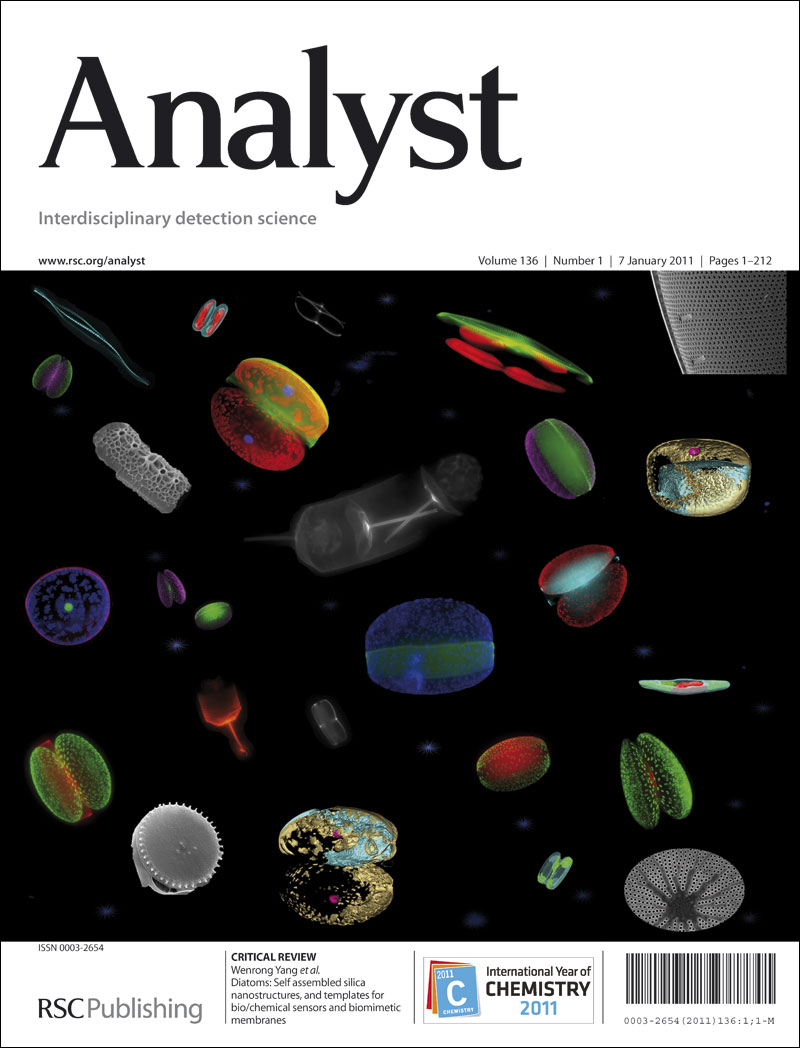基于镧系元素/核苷酸内参的新型比率荧光探针,用于检测碱性磷酸酶
IF 3.6
3区 化学
Q2 CHEMISTRY, ANALYTICAL
引用次数: 0
摘要
根据碱性磷酸酶(ALP)的特异性水解能力,以Ce3+为中心离子,三磷酸腺苷(ATP)为配体,三羟甲基氨基甲烷(Tris)为辅助配体,环丙沙星(CIP)封装在SiO2纳米颗粒中作为参考信号,构建了一种新型生物相容性的基于内参比的镧系荧光探针(CIP@SiO2-Ce/ATP-Tris)。荧光探针在 363 纳米波长发出属于 Ce3+ 的特征荧光作为工作信号,在 435 纳米波长发出属于 CIP 的特征荧光作为参考信号。去磷酸化破坏了 Ce/ATP-Tris 与 ALP 酶反应的配位,从而导致 Ce3+ 的荧光淬灭。由于封装的二氧化硅的保护作用,参考荧光保持稳定。通过比较 I435/I363 与 ALP 浓度之间的关系,实现了生物传感器分析方法。其检测限为 0.0025 U/L,线性范围为 0.1-20 U/L。随后将其用于检测胎牛血清和人血清样品中的 ALP,结果令人满意。本文章由计算机程序翻译,如有差异,请以英文原文为准。
Novel Ratiometric Fluorescent Probe based on Internal Reference of Lanthanide/nucleotide for Alkaline Phosphatase Detection
Based on the specific hydrolytic ability of alkaline phosphatase (ALP), a novel biocompatible ratiometric lanthanide fluorescent probe based on internal reference (CIP@SiO2-Ce/ATP-Tris) was constructed with Ce3+ as the central ion, adenosine triphosphate (ATP) as the ligand, Tris as the auxiliary ligand and ciprofloxacin (CIP) encapsulated into SiO2 nanoparticles as the reference signal. The fluorescent probe emits characteristic fluorescence at 363 nm belonging to Ce3+ as the working signal and at 435 nm belonging to CIP as the reference signal. Dephosphorylation disrupted the coordination of Ce/ATP-Tris with the enzymatic reaction of ALP, which resulted in a fluorescence quenching of Ce3+. The reference fluorescence was kept stable because of protective effect by encapsulated SiO2. The biosensor analysis method was achieved by comparing the relationship between I435/I363 and ALP concentration. The detection limit is 0.0025 U/L, and the linear range of detection is 0.1-20 U/L. It was subsequently used to detect ALP in samples of fetal bovine serum and human serum, and promising results were obtained.
求助全文
通过发布文献求助,成功后即可免费获取论文全文。
去求助
来源期刊

Analyst
化学-分析化学
CiteScore
7.80
自引率
4.80%
发文量
636
审稿时长
1.9 months
期刊介绍:
The home of premier fundamental discoveries, inventions and applications in the analytical and bioanalytical sciences
 求助内容:
求助内容: 应助结果提醒方式:
应助结果提醒方式:


